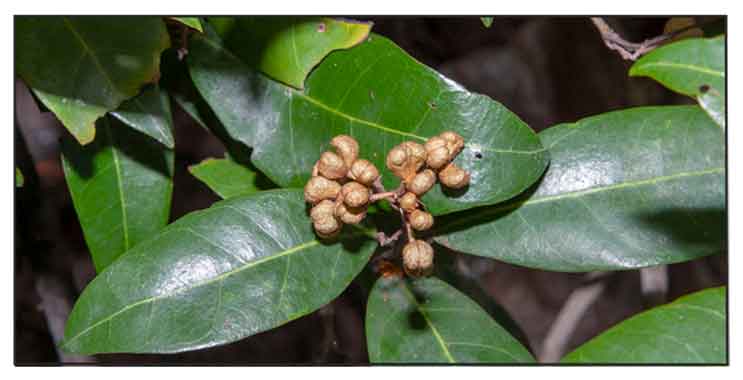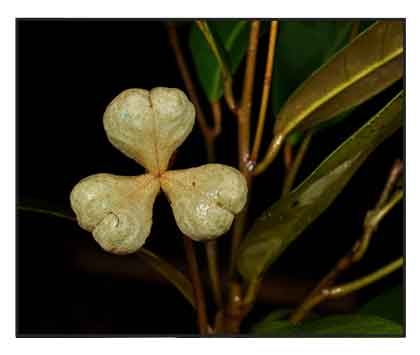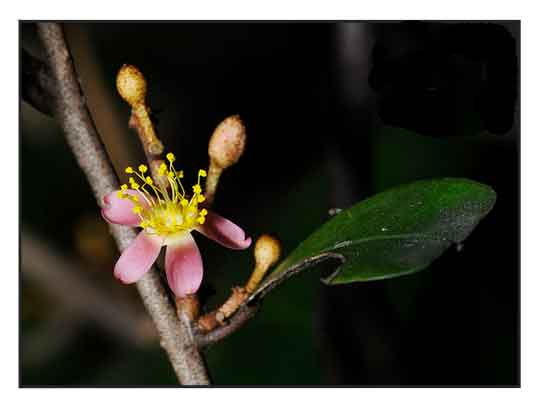
Gen info
- Brownlowia is a genus of flowering trees in the Malvaceae family with approximately 30 species worldwide. Two species, Brownlowia tersa and Brownlowia argentata, are known from mangrove communities and are classified as true mangrove species (Duke 1992; Polidoro et al., 2010).
(7)
- The Malay name "Durian laut" probably refers to the green-above-silvery-below leaves that resemble thos of the Durian tree. (5)
 Botany Botany
Brownowia tersa is a shrub to small tree growing 2-10 m high. Leaves are lanceolate, 10-21 by 2.5-6 cm; apex acute; base obtuse;margin smooth; secondary nerves 6-8 pairs, curved and anastomosing before margin; reticulate veins hardly distinct; petiole 5-10 mm long, glabrescent. Inflorescence axillary, 3-7 cm long; flower buds globose, ± 1.5 mm diam. Sepals triangular. Petals oblong, ± 4 by 1.5 mm. Stamens glabrous. Ovary globose, hairy. Fruit distinctly two-lobed, 1.5-2 by 1-1.5 cm. (2)
Distribution
- Native to the Philippines.
- Also native to Andaman Is., Bangladesh, Borneo, India, Malaya, Maluku, Myanmar, Sulawesi, Sumatera, Thailand.
- In swamp forest; altitude 0-20 m.
- Found in mangrove swamps, along creeks where mud is accreting; on sandy shores or firm mud.
- IUCN status: Near Threatened.
 Constituents Constituents
- Phytochemical screening of ethanolic leaf extract yielded carbohydrate (reducing sugars), glycosides, saponins, tannins, and flavonoids. (see study below) (3)
- Crude ethanol extract of stems yielded tannins, flavonoids, phenolic compounds, alkaloids, glycosides, saponins, terpenoids, and steroids. (see study below)
(8)
Properties
- Studies have suggested antinociceptive, antidiarrheal, antioxidant, antibacterial, anti-inflammatory, diuretic, antihyperglycemic, laxative,
anti-allergic properties.
Parts used
Stems, leaves, bark.
Uses
Folkloric
- No reported folkloric medicinal use in the Philippines.
-
Long used as a traditional folk remedy for diarrhea, dysentery, wounds and boils..
Others
- Wood: Timber used for fencing or as fuelwood.
- Bark: Used for making tying material.
Studies
• Antinociceptive / Antidiarrheal / Leaves: Study evaluated the antinociceptive and antidiarrheal activities of ethanolic extract of leaves of B. tersa. At doses of 250 and 500 mg/kbw, the extract showed significant antinociceptive activity in acetic acid induced writhing model in mice with 45.61% and 63.85% writhing inhibition (p<0.001) respectively, while standard drug diclofenac showed 76.69% inhibition at dose of 25 mg/kbw. In antidiarrheal testing in measures of reduction of rate of defecation and consistency of feces in castor oil-induced diarrhea, at dose of 500 mg/kbw the extract showed moderately significant antidiarrheal activity with 50% reduction in diarrhea (p<0.01) comparable to standard loperamide (68.53%). (see constituents above) (3)
• Antioxidant / Antibacterial / Cytotoxicity / Leaves and Bark: Study evaluated leaf and bark extracts for antioxidant, antibacterial, and cytotoxicity by brine shrimp lethality bioassay. In DPPH free radical scavenging assay, the petroleum ether, chloroform, and methanol extracts of bark and leaf showed IC50s values of 102.09, 236.28, 27.90 and 183.764, 45.78, and 35.12 µg/mL, respectively. Total phenolic content was higher in the methanolic bark and leaf extracts. Total flavonoid content was highest in the methanolic leaf extract, lowest in the chloroform extract. Petroleum ether and methanol extracts of bark and leaf showed antibacterial activity against E. coli ATCC 28739 and Pseudomonas aeruginosa ATCC 27833. (4)
• Anti-Inflammatory / Antioxidant / Leaves: Study evaluated the anti-inflammatory and antioxidant activities of ethanol leaf extract of Brownlowia tersa. At dose of 400 mg/kg, the extract showed significant anti-inflammatory activity (p<0.01) both in carrageenan and histamine-induced edema test models with 54.76% and 56..96% reduction in paw volume comparable to standard indomethacin. In DPPH free radical scavenging test, the ethanol extract showed a fairly significant IC50 of 39.33 µg/ml compared to reference standards ascorbic acid and BHA at 3.16 and 5.81 µg/ml, respectively. Total phenolic content was 211.82 mg/g GAE. Acute toxicity testing showed the plant may be safe for pharmacological uses up to 3,200 mg/kbw in rats. Results provide scientific basis for traditional uses of the plant as remedy for pain and inflammation. (6)
• Antihyperglycemic / Antiallergic / Stems: Study evaluated an ethanolic extract of stems for anti-hyperglycemic anc anti-allergic activity. Results showed considerable lowering of blood glucose level in mice by AGTT at both doses of 250 and 500 mng/kbw. Extrac t also significantly decreased allergy-type symptoms like sneezing, scratching, and nasal score induced by TDI in mice model. Acute toxicity testing showed LD50 of the extract is above 3000 mg/kbw. (see constituents above) (8)
• Diuretic / Laxative / Aerial Parts: Study evaluated the diuretic and laxative activities of different fractionated extracts of Brownlowia tersa and Kandelia candel. The chloroform extracts of aerial parts of B. tersa demonstrated better diuretic activity in measures of urine volume, pH, density, electrolyte contents. Both active fractions suggest loop diuretic effect. In laxative testing, with biscodyl as standard, B. tersa EA and water fractions demonstrated significant laxative effect. (9)
• Antihyperglycemic / Antiallergic / Leaves: Study evaluated the antidiabetic and antiallergic activities of ethanol extract of leaves. In STZ-induced diabetic mice, the extract showed significant antihyperglycemic activity at 300 and 500 mg/kg doses with significant declines in blood and urine glucose levels, along with decreases in SGPT, SGOT, creatinine, bilirubin, urea, and triglycerides. Extract also significantly reduced TDI induced allergic symptoms like sneezing (p<0.05), scratching (p<0.05) and nasal score (p<0.05). (10)
Availbility
Wild-crafted.
|

![]()




 Botany
Botany
